Fungi vs. Mushroom - Definitions and Differences


Fungi and mushrooms are often used interchangeably, leading many to confuse the two. Such confusion is understandable since the terminology is similar. One common misconception is to do with edibility. Many people call the product that we eat a mushroom and the type we see in the wild a fungus. While there is some truth to these descriptions, it does not explain the difference between fungi vs. mushroom. At thedailyECO, we explain the differences between fungus and mushroom by looking at definitions of both and a comparison between them.
Is a mushroom the same as a fungus?
No, a fungus and a mushroom are not the same in terms of terminology. We can say that a mushroom is a type of fungus, but not that a fungus is necessarily a mushroom. In a very basic way, we can say that a mushroom is a type of fungus, but not all type of fungi are mushrooms. To make the distinction, we need to define the two terms separately.
A fungus is eukaryotic organism found in the kingdom Fungi, distinct from animals and plants. They are made up of two fundamental parts:
- Mycelium: this is the fruiting part of all fungi which consists of a thin branches known as hyphae. It is often found underneath soil or another substrate, although it can also be on top of it.
- Sporocarp: also known as the fruiting body, this is where spores are located and is present during the sexual phase of the fungus's life cycle.
One way to classify fungi is by their type of reproduction and the shape of the reproductive structure. The types of reproduction that fungi present are:
- Asexual: reproduction occurs by budding or fragmentation. Such is the case of yeasts, microscopic unicellular fungi used in food production. We explain more with our article on asexual reproduction in plants and animals.
- Sexual: reproduction is by sporulation , i.e. through the production of spores that form within reproductive structures. We also have a guide to what is sporulation in biology?
In turn, within this last group of fungi, the reproductive structures can vary enormously. We often use this morphological character to classify different fungi. The reproductive structures can be:
- Conidia: as is the case with mold, a multicellular fungus that can grow on food.
- Basidia: these structures are what we find inside the fruiting body known as sporocarps.
So fungus and mushroom are not synonymous. Rather, a mushroom is a type of fungal structure. Not all fungi have such as structure, but we often conflate the two concepts. We continue our comparison of fungi vs. mushroom with a closer look at mushrooms below.
What are mushrooms?
As explained above, mushrooms are a specific type of fungal structure. They are one of the most recognizable types of fungus thanks to the fact these are the types most commonly used in cooking. One of these is the species known as the button mushroom (Agaricus bisporus). We often simply refer to these as mushrooms.
All types of mushroom have the following parts:
- Stipe: also known as the stem, this is the long supporting part of the mushroom and is composed of hyphae, but is not involved directly in reproduction.
- Pileus: is the sporocarp of the mushroom, commonly known as the cap. It is where the spores are stored for reproduction.
Also known as toadstools, mushrooms are a type of fungus that has these distinctive parts. In evolutionary terms, the stipe and the pileus are beneficial as they both help protect and spread the spores necessary for reproduction. Despite this advantageous adaptation, not all types of fungus have these parts.
Within the structure of the mushroom is the hymenophore, in which the hymenium is located. Within the hymenium are the structures responsible for the production of spores. The spores are the dispersal units that, upon finding the right conditions and germinating, will give rise to new organisms. An average mushroom can produce between 7 and 8 million spores .
Mushrooms are fleshy entities and have a great diversity of sizes, shapes and colors. Some mushrooms have the typical umbrella shape which are circular and have a flattened cap. Others may have more irregular shapes, including fan-shaped, shelf-like, woody or leathery structures without much of a stipe.
Some mushrooms are known to be edible, but not all. If you want to collect them directly from the wild you will have to be very careful when identifying the species, as some can be poisonous or even deadly. Some poisonous mushrooms can bear a great similarity to edible species, so it is imperative we use caution when foraging for mushrooms.
Learn more about fungi vs. mushrooms with our article on the structure of a fungus.

What are fungi?
Fungi can be unicellular or multicellular organisms. The vegetative body of most fungi is called the mycelium and is made up of a set of filaments known as hyphae. The mycelium generally develops below the ground, is similar to the roots of a plant and can reach several meters in size. The main task of the mycelium is to take care of the nutrition of the organism.
Fungi do not have chloroplasts like plants. They are heterotrophic organisms, meaning they feed on organic matter present in the environment. Most do so through external digestion where digestive enzymes are released to digest the food. After this time, the remaining product is then absorbed.
The types of feeding strategies that fungi present are:
- Saprophytes: feed on dead organic matter.
- Parasites: live on and feed on living organisms.
- Symbionts: live in association with other organisms, where they usually receive nutrients in exchange for protection or some other benefit.
Examples of symbiont fungi include lichens, a symbiotic association between a fungus and an algae. Another example are mycorrhizae, an association between a fungus and the roots of some plants. Discover what is symbiosis in biology with examples in our related article.
If you want to read similar articles to Fungi vs. Mushroom - Definitions and Differences, we recommend you visit our Facts about nature category.
- Alonso, J. (n.d.). Basics about macromycetes. Retrieved from: http://www.smlucus.org/UserFiles/Files/curso/1CONCEPTOS_BASICOS_SOBRE_MACROMICETOS_con_citas%281%29.pdf
- Biology and geology. Retrieved from: https://www.mheducation.es/bcv/guide/capitulo/844860766X.pdf






